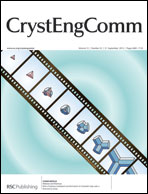Dinuclear Ag(i) metallamacrocycles of bis-N-heterocyclic carbenes bridged by calixarene fragments: synthesis, structure and chemosensing behavior†
Abstract
Dinuclear Ag(I) metallamacrocycles containing bis-N-heterocyclic carbene units and calixarene fragments [{1,1′-R2-3,3′-CH2{(p-R1-C6H2OMe)CH2}m-bisimidazol-2-ylidene}2-Ag2](PF6)2 (6a–f), (6a: m = 1, R1 = Me, R2 = Me; 6b: m = 1, R1 = t-Bu, R2 = Me; 6c: m = 1, R1 = Me, R2 = naphthylmethyl; 6d: m = 1, R1 = Me, R2 = anthrylmethyl; 6e: m = 2, R1 = Me, R2 = anthrylmethyl; 6f: m = 3, R1 = t-Bu, R2 = anthrylmethyl) were synthesized by reacting silver oxide with the corresponding bis-imidazolium salts (5a–f). Single crystal structural analyses reveal that metallamacrocycles of diverse sizes consisting of two NHC–Ag(I)–NHC units and two calixarene fragments are found in the structures of these dinuclear complexes. These complexes show different configurations with the change of the upper-rims (R1) of the calixarene fragments or N-substituents (R2) of the NHC rings. The two bis-NHC ligands in the complexes generally adopt trans-conformations except for the pair in 6b. Complexes 6a and 6c–d, in which R1 are methyl groups, show rectangular cavities in their structures. Complex 6b, in which R1 are tert-butyl groups of great steric hindrance, adopts cone conformation analogous to that of the calixarene. Interestingly, cation–π interactions are present between Ag(I) and the π–electron rich arene ring of R2 in the structures of complexes 6c–f. Intermolecular C–H⋯F hydrogen bonds exist in the crystal packing of all these complexes. Moreover, intermolecular Ag⋯Ag interactions are found in complex 6a and intermolecular π–π interactions are observed in complexes 6c–f. These intermolecular interactions lead to the formation of 2D supramolecular layers in complex 6c and 3D supramolecular networks in complexes 6a–b and 6d–f, respectively. The fluorescent chemosensing behaviors of these metallamacrocycles were explored for some neutral molecules. The results showed that 6d can behave as an efficient fluorescent chemosensor for p-benzoquinone and 6e–f exhibit fluorescent quenching behaviors for C60 or C70 fullerenes.


 Please wait while we load your content...
Please wait while we load your content...